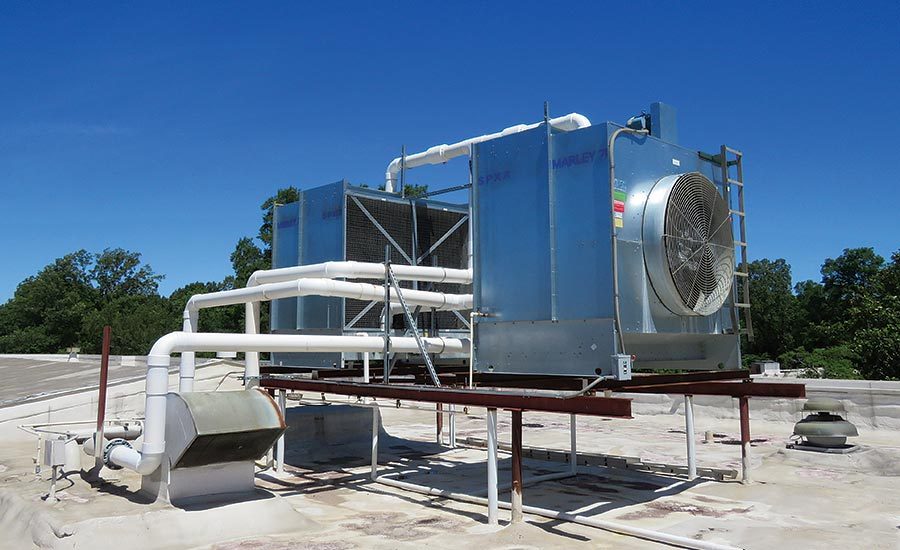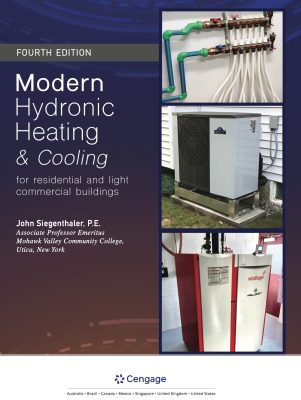Lawrence Marley: Hydronic piping
Safely making your building comfortable.

Existing hydronic pipes in a church.

Old, existing hydronic piping.

New cooling towers with new hydronic piping.



The climate control systems in most commercial buildings have very little similarities to their residential counterparts. While it is true the ultimate goal of both systems is to create a comfortable climate-controlled environment, how this is achieved is done in very different methods.
While some parceled sections of a commercial building will utilize a package unit or sometimes a roof top unit (RTU) to cool and heat a small space, in general large commercial spaces, such as hospitals or large office buildings cannot be heated and cooled in this manner.
This is because the inefficiency of moving heated and cooled air over large distances makes the utilization of a central heating and air system impossible. Instead, these systems move large amounts of heated or chilled water over large distances from a boiler or a chiller. This water is moved in a large system of hydronic pipes.
In most large commercial buildings, either heated or chilled water is moved through hydronic piping to an air handler. These air handlers will either heat or cool air for a given zone. The hydronic piping then returns the water to either the chiller or the boiler in a looped system.
In either case, the joints in the piping must be sealed. The seals on all fixtures connected to the piping must not leak, and all support hangers and valves must be firmly attached and in working order. This water can move through these hydronic piping in high pressures and at high fluid velocities. The results of a leak in the hydronic piping will create damage to the structure and to any equipment near the leak.
Design requirements
One example I was involved with occurred at a hospital in the Florida panhandle. The original hydronic piping system was run in the drop ceiling. The majority of the fixtures and valves on the second floor were placed in a space that originally was designated as a supply closet. However, the second floor was reconfigured, and this space was repurposed.
The space now contained some sensitive testing equipment. During the renovations, the hydronic piping was not inspected or serviced. Less than a year after this renovation was completed, a leak in the chilled water piping occurred, causing damages of more than $200,000 to the new equipment inside the repurposed testing facility.
The design requirements for hydronic piping are covered in section 12 of the Uniform Mechanical Code (UMC). This piping can be manufactured from both metals and plastics, as both ABS and cross-linked polyethylene (PEX) are approved materials.
However, the most common materials are ductile iron or steel piping. These pipes can run long distances from boilers and chillers outside a building, in a basement or on a roof top very efficiently providing chilled or heated water to air handlers and exchangers throughout the building.
To continuously achieve this safely, these pipes must be regularly inspected and serviced. Additionally, these piping systems have a finite life. The failure to replace these pipes at the end of this lifecycle will result in a water leak that could create considerable damage inside the building.
An example of this occurred in an old bank building in rural west Tennessee. The building had been retrofitted approximately 10 years earlier to accommodate new tenants on the second and third floors.
However, the hydronic pipes on the first floor were not replaced when the renovation was completed. This included the support hangers for the hydronic pipes. The boiler was replaced, but the owner decided not to replace the hydronic piping system. Several of the hangers rusted and failed. This allowed a check valve to fall and separate from the hydronic piping. The resulting water leak damaged the new boiler along with the rest of the first floor.
As a forensic engineer, my task is generally to supply “what happened” in a given event. The “why” or the root cause analysis is considered inconsequential in most cases. This does not mean that in many cases, the root cause is not blatantly obvious. In the example of the hospital in Florida, there were two brand new Marley cooling towers.
For the record, I have no familial relation that I’m aware of, but I sure wish I did!
In this case, the cooling towers had new hydronic piping installed on the roof, but were attached to older existing piping at the roofline. This piping was estimated to be at least 20 years of age at the time of the failure, but as the hospital had been built 35 years prior to the leak, it was entirely possible this hydronic pipe was the original piping installed. Once the piping was removed and inspected, it could be seen that large amounts of debris had built up on the inside walls of the pipes, as well as large amounts of oxidation. This would be consistent with piping that had been in use for decades.
An obvious question
What is the life span of hydronic piping, and when should it be serviced? The answer, while boring, is: It depends on usage and location. In the simplest terms though, properly serviced hydronic piping should last as long as the equipment it services.
When you replace your boiler or chiller, you should probably replace your piping. Servicing is the key here. For buildings that are continuously in use, the climate control systems would also be continuously in use.
In these cases, at the very least, annual servicing would be recommended. This should include an inspection of the piping, fixtures and supports. This could also include an inspection of the piping with a borescope camera in certain areas that might be deemed as potential troubling.
Draining and flushing the pipes during certain periods where heating or cooling are not required would also be advised to extend the lifespan of the hydronic piping. This works much like draining your water heater every two to three years; it will extend its lifespan. For example, in the winter months, it might be advisable to drain the chilled water piping and flush it out. Likewise during the summer, do the same for your heated water piping.
The biggest issue that comes up during my investigations has been building owners resisting recommendations to replace the hydronic piping in their building. I’ve developed many theories on why this occurs over the years. The obvious answer of money is probably involved, but compered to replacing a cooling tower or boiler, this expense is not nearly as substantial.
The other reasoning could involve the inconvenience of having the interior of your building being compromised during the replacement. However, the removal and replacement of the hydronic pipes can be done in phases which would limit the areas that are affected for a given time.
In the end, I believe hydronic piping does not present an obvious issue until it fails. Unlike declining efficiency in the boiler or cooling towers, the hydronic pipes work until they don’t. All replacements are essentially “preventative” and owners believe they could have “waited a little longer.” Almost as if they believe they have somehow “left money on the table” by not waiting until a failure occurred. In any event, the service and replacement of the hydronic piping in the building is as essential as the servicing of the elevator or the fire suppression system.
For commercial buildings, the hydronic pipes supplying chilled and heated water are the vital arteries. The service, maintenance and ultimate replacement of these pipes are essential to maintain a comfortable and safe environment in your building.
Looking for a reprint of this article?
From high-res PDFs to custom plaques, order your copy today!












